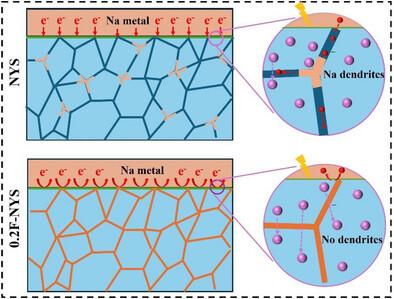Novel Sodium Rare Earth Silicate Solid Electrolyte with Grain Boundary Electronic Insulation for Ultra-Durable Solid-State Sodium Metal Batteries
IF 26.8
1区 材料科学
Q1 CHEMISTRY, MULTIDISCIPLINARY
引用次数: 0
Abstract
Sodium rare earth silicate is regarded as a novel and promising solid electrolyte (SE) for solid-state sodium metal batteries (SSSMBs) because the merits of high ionic conductivity, low sintering temperature, and excellent chemical stability. However, impurity phases and voids induced by sintering always cause weak ion conduction and large electron conduction at grain boundaries, resulting in the growth of Na dendrites. Herein, a facile grain boundary modification strategy is conducted by introducing a second phase of Na1.5Y2.5F9 into the grain boundaries of Na5YSi4O12. The Na1.5Y2.5F9 phase can not only effectively impede the migration of electrons and reduce the bulk resistance and grain boundary resistance, but also improve the densification and mechanical strength of SE. Consequently, the Na/Na symmetric cell delivers a large critical current density of 0.7 mA cm−2 and an ultra-long cycle life of 9000 h at 0.1 mA cm−2 and 0.05 mAh cm−2 without dendrite formation. Moreover, the assembled full cell achieves excellent cycling stability at 1 C for 750 cycles with a capacity retention of 70.2% and enhanced rate capability of 113.5 mAh g−1 at 2 C. This work lays a foundation to develop high-performance sodium rare earth silicate-based SE for ultra-durable SSSMBs.

超耐用固态钠金属电池用新型晶界电子绝缘稀土硅酸钠固体电解质
稀土硅酸钠具有离子电导率高、烧结温度低、化学稳定性好等优点,是一种很有前途的固态金属钠电池固体电解质。然而,烧结过程中产生的杂质相和空洞往往在晶界处引起弱离子传导和大电子传导,导致Na枝晶生长。本文通过在Na5YSi4O12晶界中引入第二相Na1.5Y2.5F9,实现了一种简便的晶界改性策略。Na1.5Y2.5F9相不仅能有效阻碍电子迁移,降低体电阻和晶界电阻,还能提高SE的致密化和机械强度。因此,Na/Na对称电池提供了0.7 mA cm - 2的大临界电流密度,并在0.1 mA cm - 2和0.05 mAh cm - 2下具有9000 h的超长循环寿命,而不会形成树突。此外,组装的全电池在1℃下具有良好的750次循环稳定性,容量保持率为70.2%,在2℃下提高了113.5 mAh g−1的倍率容量。该工作为开发高性能的超耐用SSSMBs稀土硅酸盐钠基SE奠定了基础。
本文章由计算机程序翻译,如有差异,请以英文原文为准。
求助全文
约1分钟内获得全文
求助全文
来源期刊

Advanced Materials
工程技术-材料科学:综合
CiteScore
43.00
自引率
4.10%
发文量
2182
审稿时长
2 months
期刊介绍:
Advanced Materials, one of the world's most prestigious journals and the foundation of the Advanced portfolio, is the home of choice for best-in-class materials science for more than 30 years. Following this fast-growing and interdisciplinary field, we are considering and publishing the most important discoveries on any and all materials from materials scientists, chemists, physicists, engineers as well as health and life scientists and bringing you the latest results and trends in modern materials-related research every week.
 求助内容:
求助内容: 应助结果提醒方式:
应助结果提醒方式:


